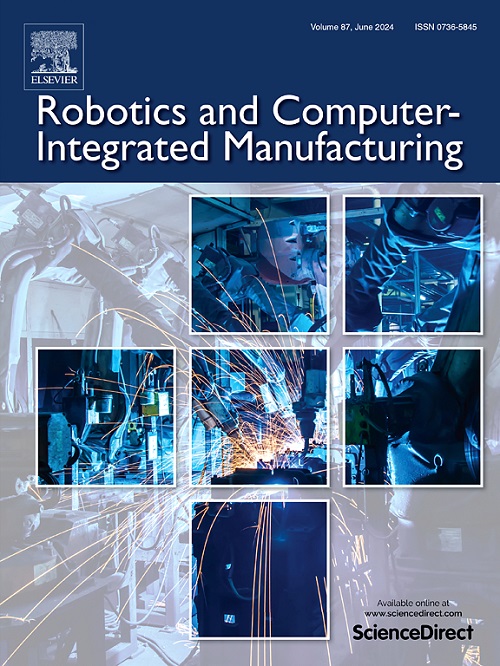Task-aware motion planning in constrained environments using GMM-informed RRT planners
IF 11.4
1区 计算机科学
Q1 COMPUTER SCIENCE, INTERDISCIPLINARY APPLICATIONS
引用次数: 0
Abstract
This paper introduces a novel integration of Task-Parameterized Gaussian Mixture Models (TP-GMM) with sampling-based motion planners, specifically RRT, to improve planning efficiency and path optimality in constrained robotic manipulation tasks. The proposed GMM-RRT and GMR-RRT planners exploit a TP-GMM trained offline on human demonstrations to generate task-adaptive sampling distributions, effectively guiding the search toward feasible and high-quality solutions. The framework is implemented in the MoveIt motion planning framework and evaluated across five simulation experiments and 30 real-world trials, focusing on Electric Vehicle (EV) battery disassembly tasks. Compared to baseline sampling-based planners, the GMM-informed planners demonstrate superior performance in key planning metrics. In the path length aspect, GMM planners yield significantly shorter trajectories, averaging 0.8 meters versus over 2 meters for baseline planners. Similarly, in path simplification time, the near-optimal nature of the generated paths reduces post-processing efforts. While planning time is higher due to TP-GMM inference and projection stages, over 90% of that time is spent outside the RRT search itself, which completes quickly due to guided sampling. Path duration also remains competitive, with GMM-informed planners closely matching RRT*. These results highlight the effectiveness of task-conditioned sampling in unstructured manipulation scenarios. The proposed method maintains 100% success rate while improving efficiency, suggesting strong potential for integration in sequential and adaptive robotic systems. Future work will focus on extending generalization to broader task parameter spaces and addressing inverse kinematics challenges.

任务感知运动规划在约束环境中使用gmm通知的RRT计划
本文介绍了一种将任务参数化高斯混合模型(TP-GMM)与基于采样的运动规划器(特别是RRT)相结合的新方法,以提高约束机器人操作任务的规划效率和路径最优性。提出的GMM-RRT和GMR-RRT规划者利用在人类演示中离线训练的TP-GMM来生成任务自适应抽样分布,有效地指导对可行和高质量解决方案的搜索。该框架在MoveIt运动规划框架中实施,并通过5个模拟实验和30个真实世界试验进行评估,重点关注电动汽车(EV)电池拆卸任务。与基于基线抽样的规划者相比,gmm知情规划者在关键规划指标上表现优异。在路径长度方面,GMM规划器产生的轨迹明显较短,平均为0.8米,而基线规划器的轨迹超过2米。同样,在路径简化时间中,生成路径的接近最优性质减少了后处理工作。虽然由于TP-GMM推断和投影阶段,计划时间更高,但超过90%的时间花费在RRT搜索本身之外,由于引导采样,RRT搜索很快完成。路径持续时间也具有竞争力,gmm信息规划者与RRT*密切匹配。这些结果突出了任务条件采样在非结构化操作场景中的有效性。该方法在提高效率的同时保持了100%的成功率,在序列和自适应机器人系统中具有很强的集成潜力。未来的工作将集中于将泛化扩展到更广泛的任务参数空间和解决逆运动学挑战。
本文章由计算机程序翻译,如有差异,请以英文原文为准。
求助全文
约1分钟内获得全文
求助全文
来源期刊
CiteScore
24.10
自引率
13.50%
发文量
160
审稿时长
50 days
期刊介绍:
The journal, Robotics and Computer-Integrated Manufacturing, focuses on sharing research applications that contribute to the development of new or enhanced robotics, manufacturing technologies, and innovative manufacturing strategies that are relevant to industry. Papers that combine theory and experimental validation are preferred, while review papers on current robotics and manufacturing issues are also considered. However, papers on traditional machining processes, modeling and simulation, supply chain management, and resource optimization are generally not within the scope of the journal, as there are more appropriate journals for these topics. Similarly, papers that are overly theoretical or mathematical will be directed to other suitable journals. The journal welcomes original papers in areas such as industrial robotics, human-robot collaboration in manufacturing, cloud-based manufacturing, cyber-physical production systems, big data analytics in manufacturing, smart mechatronics, machine learning, adaptive and sustainable manufacturing, and other fields involving unique manufacturing technologies.

 求助内容:
求助内容: 应助结果提醒方式:
应助结果提醒方式:


